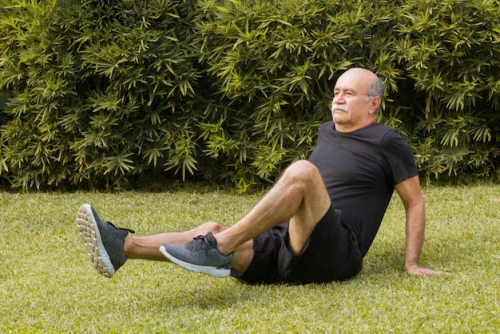Arthritis is a common condition that affects millions of people worldwide, particularly in the knee joints. It can cause significant pain, stiffness, and swelling, leading to difficulty in performing everyday activities. Knee arthritis occurs when the cartilage that cushions the knee joint breaks down, leading to inflammation, pain, and limited movement. While there is no cure for arthritis, there are various ways to manage the symptoms and improve quality of life.
One of the most effective treatments for knee exercises for arthritis. Strengthening the muscles around the knee, improving flexibility, and increasing range of motion can help reduce pain and stiffness. In this blog, we will explore some of the top knee exercises that can help reduce arthritis pain, improve mobility, and increase overall knee function.
1. Quad Sets (Quadriceps Sets)
The quadriceps are the large muscles at the front of the thigh. Strengthening these muscles is crucial for people with knee arthritis because they help support the knee joint. Quad sets are a simple exercise that targets the quadriceps without putting too much strain on the knee.
How to Do It:
Sit with your legs straight out in front of you, either on the floor or on a bed.
Tighten the muscles on the top of your thigh by pushing the back of your knee down towards the floor.
Hold for 5 to 10 seconds, then relax.
Repeat the exercise 10 to 15 times, working up to 3 sets.
Benefits:
Strengthens the quadriceps, which can help reduce knee pain.
Improves knee stability and function.
Can be done at home without any special equipment.
2. Straight Leg Raises
Straight leg raises are another exercise that strengthens the quadriceps and the muscles around the knee joint. This exercise also helps improve knee stability and reduces strain on the joint.
How to Do It:
Lie flat on your back with one knee bent and the other leg straight.
Tighten the muscles in your straight leg and lift it about 6 to 12 inches off the ground.
Hold the leg in the air for 5 to 10 seconds, then slowly lower it back down.
Repeat the exercise 10 to 15 times on each leg, aiming for 3 sets.
Benefits:
Strengthens the quadriceps and other muscles around the knee.
Helps improve knee stability.
Easy to perform and does not put excess stress on the knee joint.
3. Hamstring Curls
The hamstrings are the muscles at the back of your thigh. Strengthening the hamstrings is just as important as strengthening the quadriceps because they help stabilize the knee joint and assist in bending the knee. Hamstring curls help improve the flexibility and strength of these muscles.
How to Do It:
Stand tall and hold onto a chair or countertop for balance.
Slowly bend one knee, bringing your heel toward your buttocks.
Hold the position for 5 to 10 seconds, then slowly lower your leg back down.
Repeat 10 to 15 times on each leg, aiming for 3 sets.
Benefits:
Strengthens the hamstrings and improves knee stability.
Can help reduce knee pain and stiffness.
Improves mobility and function.
4. Step-Ups
Step-ups are an excellent exercise for strengthening the muscles around the knee joint, particularly the quadriceps, hamstrings, and calves. This exercise also mimics the natural motion of walking, which is beneficial for those with knee arthritis.
How to Do It:
Stand in front of a low step or platform (about 6 inches high).
Step up onto the platform with one foot, straightening your leg as you rise.
Step down slowly with the same leg.
Repeat 10 to 15 times on each leg, working up to 3 sets.
Benefits:
Strengthens the quadriceps, hamstrings, and calves.
Improves balance and coordination.
Mimics walking, which can help improve overall mobility.
5. Wall Squats
Wall squats help strengthen the muscles around the knee and improve flexibility. They focus on the quadriceps and can be modified based on your pain level.
How to Do It:
Stand with your back against a wall and your feet about shoulder-width apart.
Slowly slide your back down the wall, bending your knees at a 45-degree angle (or less if needed).
Hold the squat position for 5 to 10 seconds, then slowly slide back up to the starting position.
Repeat the exercise 10 to 15 times, aiming for 3 sets.
Benefits:
Strengthens the quadriceps and other muscles around the knee joint.
Improves knee stability and balance.
Can be done with minimal strain on the knees by adjusting the depth of the squat.
6. Calf Raises
Calf raises strengthen the calf muscles and improve the overall strength of the lower leg. This exercise can help improve balance and stability, which is important for preventing falls in people with knee arthritis.
How to Do It:
Stand with your feet shoulder-width apart, holding onto a chair or countertop for balance.
Slowly raise your heels off the ground, lifting your body weight onto the balls of your feet.
Hold the position for a few seconds, then slowly lower your heels back to the ground.
Repeat the exercise 10 to 15 times, working up to 3 sets.
Benefits:
Strengthens the calf muscles, which helps with stability.
Improves balance and coordination.
Relieves pressure on the knees by distributing weight more evenly.
7. Seated Leg Extensions
Seated leg extensions target the quadriceps muscles, helping to improve knee strength and flexibility. This exercise can be done while sitting in a chair, making it an excellent option for those with limited mobility.
How to Do It:
Sit in a chair with your feet flat on the ground and your knees bent.
Slowly extend one leg out in front of you, straightening your knee as much as possible.
Hold the extended position for a few seconds, then slowly lower your leg back down.
Repeat 10 to 15 times on each leg, aiming for 3 sets.
Benefits:
Strengthens the quadriceps.
Improves knee range of motion and flexibility.
Can be done in a seated position, making it easier for people with limited mobility.
8. Cycling (Stationary or Regular)
Cycling is a low-impact aerobic exercise that helps improve knee flexibility, strength, and range of motion. It also provides a good cardiovascular workout without putting excessive stress on the joints.
How to Do It:
Use a stationary bike or ride a regular bicycle, making sure the seat is adjusted to the right height for comfort.
Pedal at a steady pace for 10 to 20 minutes, gradually increasing the duration as tolerated.
Benefits:
Improves knee flexibility and strength.
Provides a low-impact cardiovascular workout.
Reduces pain and stiffness through gentle movement.
Conclusion
Exercise plays a crucial role in managing knee arthritis and improving overall joint health. The exercises listed above focus on strengthening the muscles around the knee, improving flexibility, and increasing range of motion, all of which can help reduce pain, stiffness, and swelling. When done regularly and in combination with other treatments, these exercises can help you maintain knee function and improve your quality of life.
Always consult with your healthcare provider before starting any exercise routine, especially if you have knee arthritis or other underlying health conditions. A physical therapist can also help tailor an exercise program to your specific needs, ensuring you get the most benefit while avoiding unnecessary strain on your knees.








 Tax Planning Secrets Millionaires Don’t Want You To Know
Tax Planning Secrets Millionaires Don’t Want You To Know



